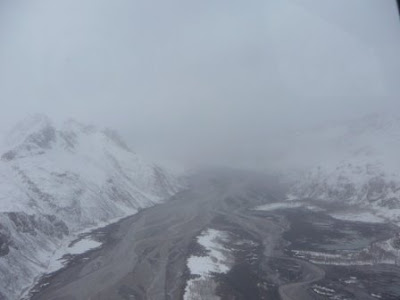Scott and I chartered a plane with a news outlet from Anchorage and flew over to the west side of the Cook Inlet to take a look at the Drift River Terminal, an oil storage facility at the mouth of the river on the lonely coastline.
I'll let the photos do the talking in this post, to read more visit the Clarion.
 Here's a photos of the river mouth taken when I flew out there in February.
Here's a photos of the river mouth taken when I flew out there in February. Early Monday morning the intense heat of Redoubts first five eruptions melted parts of the Drift Glacier sending it cascading out of the mountains and through the valley below.
Early Monday morning the intense heat of Redoubts first five eruptions melted parts of the Drift Glacier sending it cascading out of the mountains and through the valley below.
 The wall of mud, boulders, logs, volcanic debris and glacial melts charged out into the river’s flood plain at a flow rate that has yet to be calculated but could put the Mississippi River to shame.
The wall of mud, boulders, logs, volcanic debris and glacial melts charged out into the river’s flood plain at a flow rate that has yet to be calculated but could put the Mississippi River to shame. 
 Literal mountains of mud and ice were sloshed up on either side of the raging river that scoured away everything on the valley floor.
Literal mountains of mud and ice were sloshed up on either side of the raging river that scoured away everything on the valley floor.
 The oil terminal is a rectangle of order amidst a river of chaos. The black strip (click lower image to enlarge) perpendicular to the storage tanks is the former runway. It is now buried several feet deep in mud.
The oil terminal is a rectangle of order amidst a river of chaos. The black strip (click lower image to enlarge) perpendicular to the storage tanks is the former runway. It is now buried several feet deep in mud.
The next four pictures of the facility are from a press release issued by Cook Inlet Pipe Line Co. I was unable to take any photos while we flew over the facility as I was taking notes and trying to lock in the imagery for the story.
 Mud has just begun to overtake the levees built up around the facility.
Mud has just begun to overtake the levees built up around the facility.
 Not all areas of the compound were as affected. The runway undoubtedly took it the worst, but unfortunately I don't have any pics from that.
Not all areas of the compound were as affected. The runway undoubtedly took it the worst, but unfortunately I don't have any pics from that.Over 6 million gallons of Cook Inlet crude, or two thirds the amount spilled by the Exxon-Valdez on the other side of the peninsula twenty years ago Tuesday, is being stored in two tanks at the DRT right now. Three of the facility's seven tanks are out of commission and not considered a risk. The oil is being kept in the two selected tanks to keep them grounded should the levees fail. Environmental groups are calling on CIPL to get a tanker to the area and remove the remaining oil. Meanwhile scientists at AVO are saying future eruptions could cause more flooding. With the channel of the river now running up against one side of the earthen levee and mud spilling over in other locations, the pieces for a potential catastrophe all seem like they’re in place. Then again, perhaps even if the walls come down, the tanks will stay put and hold the toxic oil back.
I hope that’s not going to be on the test.
I hope that’s not going to be on the test.














No comments:
Post a Comment